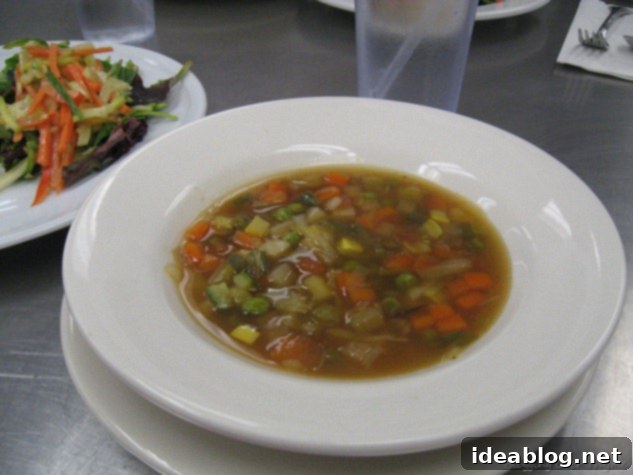Culinary School Immersion: Mastering Fundamentals in Week One
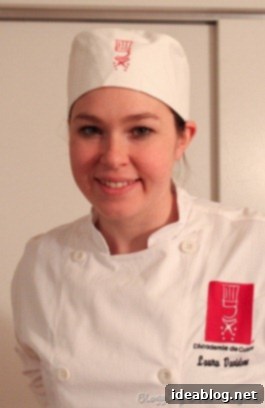
It’s hard to believe that the whirlwind of our first week at culinary school has already concluded. The days have flown by in a blur of intense learning, hands-on practice, and constant surprises, leaving me still somewhat in disbelief that this incredible journey has truly begun. This initial dive into professional culinary arts has been nothing short of exhilarating, laying a crucial groundwork for what’s to come.
Our Friday class centered around a classic French preparation: POTAGE CULTIVATEUR. For those wondering why I often capitalize these menu items, it’s a simple trick we employ to avoid the complexities of French accent marks in everyday notes – a rather convenient solution in a fast-paced kitchen environment!
Understanding Potage Cultivateur: More Than Just Soup
As we learned in our morning lecture, a potage cultivateur essentially translates to ‘Farmer’s Soup.’ However, it’s far more nuanced than the typical soup most of us are familiar with. The term “potage” carries a distinct culinary pedigree. Unlike a generic soup, which can be started with almost any aromatic base like onions, a potage is almost invariably initiated with leeks. This foundational ingredient, combined with a medley of whatever fresh, seasonal vegetables are available, gives it its rustic charm and distinct flavor profile. It’s a celebration of nature’s bounty, reflecting the simplicity and resourcefulness of traditional farm-to-table cooking.
Our daily ingredients for this particular potage included a vibrant array of vegetables in relatively equal proportions: tender leeks, earthy turnips, crisp cabbage, sweet carrots, starchy potatoes, bright peas, aromatic celery, juicy tomatoes, sunny yellow squash, and firm zucchini. And yes, a touch of smoky bacon was added for an extra layer of flavor. A running joke, or perhaps a fundamental rule, in culinary school seems to be: when in doubt, add bacon or cook with rendered bacon fat. While I’m still developing my personal culinary philosophy, I’m certainly embracing these chef-approved traditions!
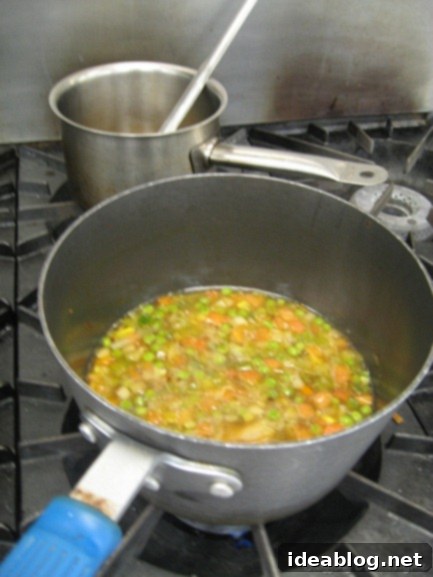
The Art of Knife Skills: Precision and Purpose
One of the primary reasons for preparing this potage was to hone our essential knife skills, which remain a continuous area of focus and improvement. The bedrock principle for any soup, especially a refined potage, is to achieve uniform ingredient sizing. This isn’t merely for aesthetic appeal, though presentation is always paramount in professional cooking. The main, practical reason for uniform cuts is to ensure that every ingredient cooks evenly. Imagine biting into a soup where some vegetables are perfectly tender while others are still stubbornly raw or mushy – not an ideal dining experience. As our chef aptly put it, you don’t want a guest lifting their spoon only to find a single, disproportionately large piece of one vegetable. Consistency in size guarantees consistent cooking and a harmonious texture in every spoonful, elevating the entire dish.
For our potage, we were tasked with chopping every single vegetable into a precise small dice – specifically, a 1/2 inch by 1/2 inch cube. This meticulous attention to detail is critical. Since our recipe incorporated frozen peas, ensuring our diced vegetables were roughly the same size as the peas was an important consideration, contributing to both visual harmony and cooking uniformity. The cooking process began by ‘sweating’ the leeks, a technique that involves gently cooking them over low heat to release their moisture and soften them without allowing them to brown. After the leeks were translucent and tender, we added the stock, then proceeded to incorporate each vegetable according to its individual cooking time. Longer-cooking vegetables like turnips and carrots went in first, followed by others in succession, ensuring that everything reached perfect tenderness simultaneously.
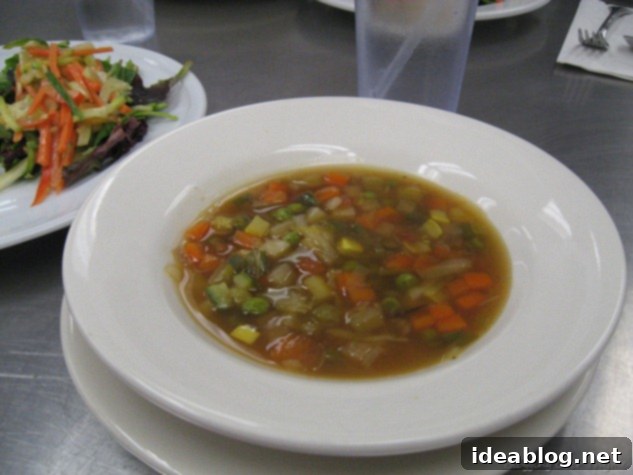
Mise en Place: The Foundation of Kitchen Efficiency
Perhaps one of the most profound and frequently emphasized lessons we’ve received in culinary school thus far, reiterated almost daily, is the indispensable importance of preparing your MISE EN PLACE before even thinking about cooking anything. In French, this phrase literally translates to “everything in its place.” In a practical kitchen context, this means meticulously preparing every single ingredient – washing, peeling, chopping, measuring – and having it organized and ready in individual containers before you begin any cooking step. At school, we utilize reusable deli cups for this purpose, which is both practical and sustainable.
The philosophy behind mise en place is simple yet transformative: it ensures you are in complete control of your cooking process. Instead of frantically searching for ingredients or rushing to chop an item at the last minute, you can focus entirely on the cooking techniques, timing, and flavor adjustments. This organized approach drastically reduces stress, minimizes errors, and makes the entire culinary experience significantly more efficient and enjoyable. I’ve found that I truly enjoy this preparatory step, and I wholeheartedly encourage everyone, even home cooks, to adopt this practice at least once. You’ll be amazed at how much more relaxed and rewarding cooking becomes when all your elements are meticulously prepared in advance.
Crafting the Quiche du Jour and Composed Salad
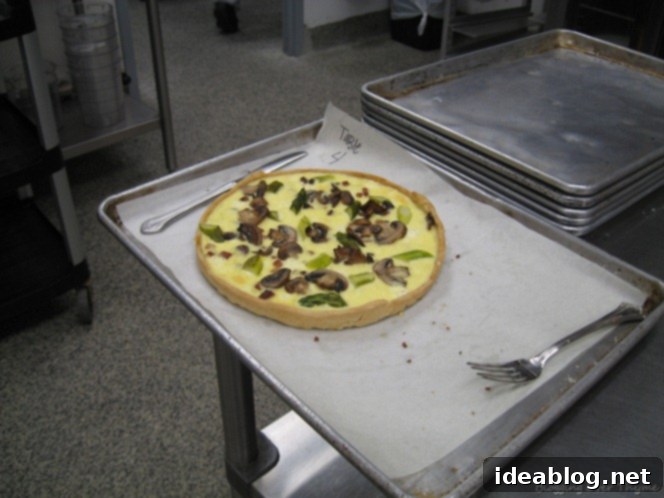
In addition to the comforting potage, our class was also tasked with creating yet another quiche! This was our QUICHE DU JOUR—a “quiche of the day” concept, designed to utilize ingredients we had readily available. Since we all had leftover pate brisee dough from previous lessons, the chefs seized the opportunity for us to further refine our pastry skills. This meant practicing the intricate steps of rolling out the delicate dough, meticulously molding it into the tart pan, blind baking it to prevent a soggy bottom, and then docking (piercing with a fork) to release steam and prevent the crust from puffing up excessively. To introduce some variety and challenge, this time we prepared an 8-inch quiche, filling it with a delightful combination of tangy goat cheese, tender asparagus, earthy mushrooms, and, once again, the ever-present bacon!
To ensure optimal flavor and texture in our quiche, we pre-cooked both the asparagus and mushrooms. The mushrooms were thinly and uniformly sliced, then quickly sautéed – a technique meaning to literally ‘jump in the pan,’ involving cooking over high heat with minimal fat – in clarified butter. The goal here was to drive out as much moisture as possible, preventing our quiche from becoming watery. For the asparagus, we carefully peeled the lower two inches of the stalks, then blanched them in highly salted boiling water until they were perfectly tender-crisp. We learned in lecture that the generous addition of salt to the boiling water not only enhances the asparagus’s flavor but also helps to preserve its vibrant green color and improves its overall texture. Immediately after cooking, the asparagus was plunged into an ice bath to halt the cooking process, ensuring they retained their crispness. Finally, they were blotted thoroughly dry before being chopped and incorporated into the quiche filling.
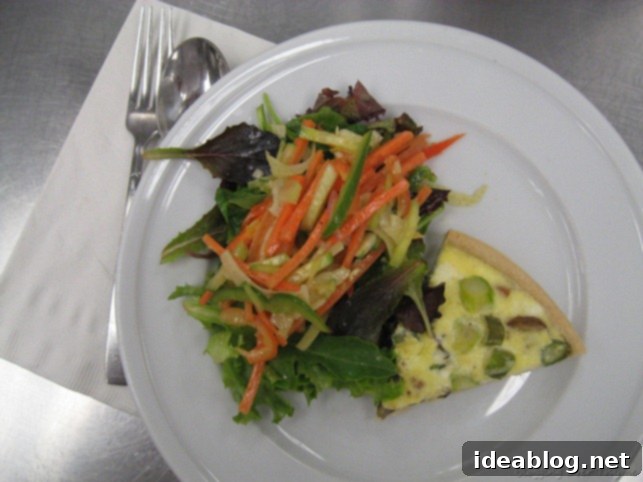
To complement our main dishes, we also swiftly assembled a refreshing LA SALADE COMPOSEE, or ‘composed salad.’ This involved meticulously julienning (cutting into precise 1/8 inch by 1/8 inch by 2-inch sticks) colorful bell peppers, crisp carrots, crunchy celery, and cool cucumber. Demonstrating our evolving knife proficiency, we also used our chef’s knives to thinly shave a delicate fennel bulb, adding a subtle anise flavor and elegant texture to the salad. I sincerely hope that these vibrant and healthy vegetable-centric dishes continue to feature prominently on our daily menus for the foreseeable future, as they offer both excellent practice and delicious results.
All of these culinary creations had to be completed, plated, and impeccably served, with all utensils and water glasses perfectly set, by 11:45 AM. This is the designated time when the Phase I pastry students join us, eager to sample and enjoy the savory masterpieces we’ve prepared. Friday’s quiche, with its rich goat cheese and perfectly cooked asparagus and mushrooms—some of my absolute favorite vegetables—was arguably even better than the one we made the day before. The light vegetable potage, alongside the colorful and refreshing composed salad, provided a wonderfully balanced and incredibly satisfying meal.
A Taste of Sweet Success: Pastry Creations and Post-Lunch Tasks
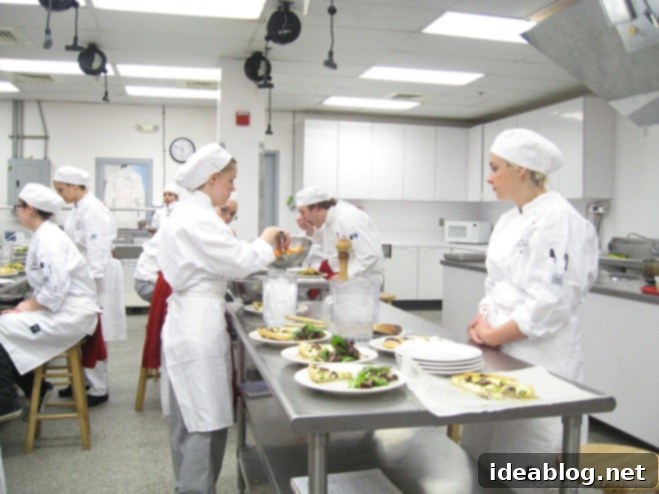
True to tradition, the pastry students reciprocated our generosity by bringing us their delectable creations of the day. This time, we were treated to exquisitely crafted, coffee-flavored eclairs and delicate profiteroles. I confess, I couldn’t resist indulging in an éclair, and it was utterly delicious – a perfect balance of rich coffee cream and light choux pastry. It was also interesting to note how much smaller and more refined these were compared to the often-ginormous versions commonly found in many American bakeries, highlighting the precision of classical pastry techniques.
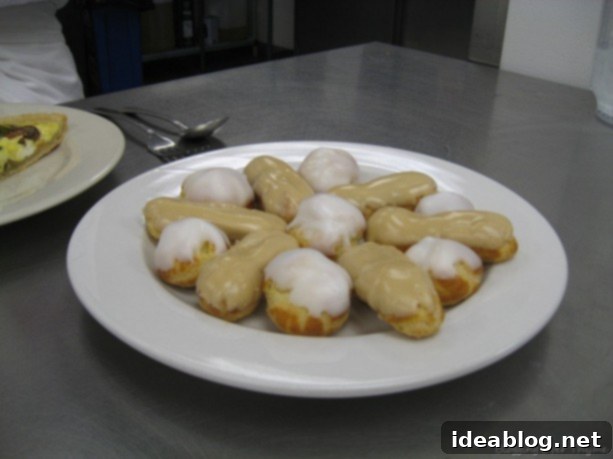
The Unsung Hero: Stockpot Cleaning
Following the delightful lunch, it was time for the less glamorous but equally crucial task: cleaning. For me, this proved to be a particularly labor-intensive undertaking. I was assigned the monumental task of cleaning the enormous stockpot that had previously held a batch of simmering chicken stock. This marked our group’s inaugural experience with this particular cleaning duty, and it was certainly an *interesting* initiation into the less glamorous realities of a professional kitchen.
As I mentioned earlier in the week, after each batch of homemade stock is fully utilized across the school, our group is responsible for meticulously cleaning the colossal stockpot and initiating the next batch. This rigorous process involves painstakingly removing all the cooked bones and the spent mirepoix (the aromatic base of onions, celery, and carrots) which, after stewing for countless hours, transforms into a rather unappetizing sight. The image below certainly isn’t a pretty picture, but it’s a testament to the flavors extracted for our stocks!
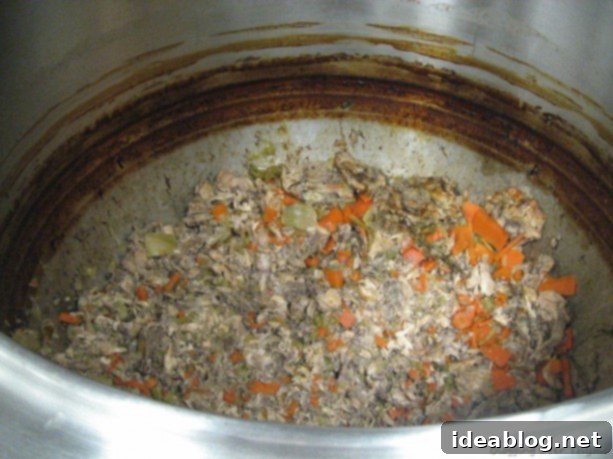
Cleaning this behemoth of a pot required stepping onto a foot ladder and literally using a smaller stockpot to scoop out its dense contents, which easily weighed close to 50 pounds. These heavy, used ingredients were then carefully transferred into a heavy-lined trashcan. Only then could the real scrubbing begin – from top to bottom! We wielded a very large, stiff-bristled brush, scrubbing back and forth with considerable force until every one of those stubborn, dark rings that had formed around the edge from hours of stewing was meticulously removed. The pot, once dull and encrusted, eventually gleamed shiny and clean again. I even joked with my chef instructor that the inventor of these industrial-sized stockpots should have seriously considered integrating a “self-clean” feature. My classmate Kevin and I dedicated nearly 45 minutes to this single task alone – perhaps that’s how I finally burned off that delicious éclair!
The Science of Measurement and Knife Care
The remainder of our afternoon was spent in the classroom, delving into a critical discussion on weights and measures. This foundational knowledge is non-negotiable in a professional kitchen. We are expected to know our measurements, primarily volume in our specific curriculum, both forwards and backward. This means being able to instantly recall, for instance, how many teaspoons are in a gallon, or how many ounces in a liter, without hesitation. Precision in measurement is paramount for consistent recipes and scalable production, and mastering it early is a key step toward becoming a competent chef. Oh, the mental gymnastics required!
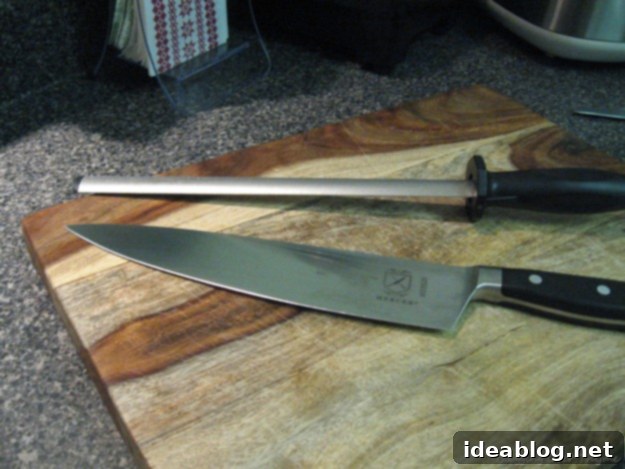
We also eagerly learned the proper technique for honing our knives, a skill I was particularly excited to acquire. Honing, performed using a honing steel (as depicted above), is a vital daily maintenance task. Its purpose is to realign the microscopic edge of the knife blade, keeping it straight and thus maintaining its sharpness. It’s crucial to understand that honing *maintains* sharpness; it does not *sharpen* the knife, which is a fundamentally different process. While honing can extend the life of your blade’s edge, improper technique can actually cause more damage. It’s an essential skill we are expected to practice at least once, if not multiple times, throughout each day. As a rule of thumb, our chef instructed us that we should effortlessly be able to slice through the delicate skin of a ripe tomato with our chef’s knife every single day.
Sharpening, conversely, is an entirely different procedure, typically done with a wet-stone (available in various grits for different knife materials). This process literally involves shaving tiny amounts of metal from the blade, actively creating a new, sharper edge. While sharpening makes a knife *sharper*, it also gradually reduces the size and life of the blade. By consistently honing your knife, you significantly decrease the frequency with which you need to resort to sharpening, thereby preserving your valuable kitchen tools for longer.
Chef Brian also offered invaluable advice, suggesting that one should probably never spend more than $100 on a chef’s knife, especially when starting out. He emphasized that the ultimate utility and effectiveness of your knife in daily use depend far more on consistent maintenance through honing than on its initial purchase price. A $200-$300 chef’s knife, no matter how prestigious, will be rendered ineffective in the long run if it’s not regularly honed and cared for. This practical wisdom resonated deeply, highlighting that skill and habit outweigh expensive equipment.
I found all of these discussions incredibly insightful and immediately put them into practice multiple times over the weekend. I’ll be back soon to share more tales from culinary school as this exciting journey continues. Who knows what new challenges and delicious lessons await us in the coming week!
P.S. Don’t forget to check out my culinary school page, which features a fantastic video showcasing my school’s comprehensive culinary arts program! I’m constantly updating this page with more insights and experiences, so stay tuned…
